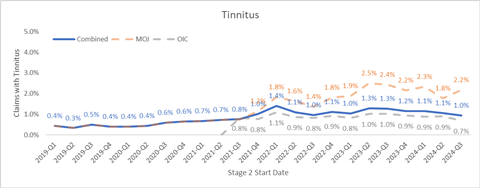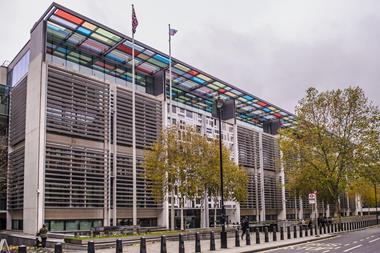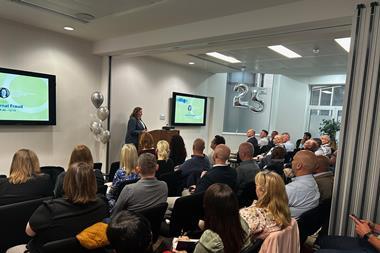With tinnitus injuries attracting anything up to £90,000 in claim payouts, squashing fraud in this area is vitally important in protecting both policyholder and insurer purse strings
Over the last 18 months, fraudulent tinnitus claims that are submitted following a road traffic accident (RTA) have swiftly become “an inherent, major issue” for motor insurers, with industry commentators describing this phenomenon as “a major problem” that demonstrates there is something “fundamentally wrong and fundamentally broken” in the post-whiplash reform claims process.

According to the NHS, tinnitus is a condition whereby individuals hear noises that cannot be attributed to an outside source. Often described as a consistent background noise in either one or both ears, these sounds can include ringing, buzzing, whooshing, hissing or humming, for example.
Prior to the introduction of the whiplash reform in May 2021 – which included a structured tariff table setting whiplash-related compensation awards based on injury duration – tinnitus was often bundled into whiplash settlements on the rare occasion it resulted from a RTA.
However, feedback from industry participants operating in the motor market suggests that, post-reform, tinnitus is being used by fraudsters to boost compensation awards and defeat the stringent specifications of the Official Injury Claim (OIC) portal’s tariff table.
For example, Nathan Jones, a paralegal at law firm DWF Law, told Insurance Times that he had noted an “upward spike” in tinnitus claims since as far back as 2017.
In particular, he believes the last 18 months have been rife in terms of tinnitus fraud. With these cases now occupying half of his case load, Jones has successfully defeated 24 consecutive tinnitus claim disputes over this period, with a further 50 active cases still on his desk.
Similarly, Simon Bradshaw, head of personal injury at Verisk Claims UK, has recorded an increase in tinnitus based on the medical reports that flow through Verisk’s portal – the platform handles around two-thirds of the motor market’s data, he explained.
Its data pinpointed a rise in tinnitus becoming more noticeable from 2020’s quarter three.
By the end of 2019, tinnitus featuring in whiplash claims occurred in just under 0.5% of the cases Verisk managed. However, by Q3 2020, this number had increased, with a further “jump” recorded in the first half of 2021 – in line with the whiplash reform becoming effective. At this point, the tinnitus element on whiplash claims appeared in “just over 1%” of cases, Bradshaw said.
Sam Lee, fraud risk and technical manager at Markerstudy, is also observing this trend.
He told Insurance Times: “I see it as a big problem. We noticed an increasing number of claims coming in for tinnitus around February, March last year. Tinnitus is a major problem. It really has picked up in the last 18 months.
“Since [March 2023], we’ve ringfenced hundreds of questionable tinnitus claims. The fact that it’s suddenly grown speaks volumes.”

Ballooning
But why does tinnitus pose such an attractive opportunity for fraudsters?
For starters, the fact that tinnitus is a subjective, sensory injury means it is near impossible to prove whether someone actually has the condition, Jones said, meaning that it could be an easy win for scammers.
“It is a completely subjective phenomenon. You’re entirely reliant on the person you’re speaking to being honest and credible about what they’re hearing. And this is where, for us, it’s become a problem,” he noted.
Another key driver is the compensation structure of the whiplash reform.
With the tariff table designed to reduce the cost of whiplash claims, fraudsters are having to look beyond standard whiplash injuries if they want to cash in on an inflated or fake injury claim.
“That’s one of the biggest challenges that we’ve got,” Bradshaw noted.
“In the pre-reform world, the majority of the compensation was in relation to the whiplash injury. In this post-reform world, the majority of the compensation is going to be in relation to the non-tariff injuries and non-whiplash injuries.
“And so, we are going to see a creep in these injuries – not necessarily because these injuries didn’t exist previously, but because there’s more impact on the level of compensation by reporting these injuries [now].
“What we’re seeing now is that those injuries that would have been deemed less severe previously are now being deemed more severe simply because of the level of compensation that they attract, rather than the actual severity of the pain and suffering.”
Where the tariff table allocates award amounts based on duration is a further motivation for fraudsters, Jones added, because it is assumed that tinnitus will have “a permanent effect on your senses”. In turn, this results in higher claims payouts compared to an injury which will heal within a few months.
There is also the potential for layering on the cost of aids and alleged treatments, according to Paul Holmes, partner at DWF Law – with insurers ultimately required to foot the bill.
For example, he described “hugely expensive hearing aid claims” becoming more common, which can include replacement aids every five years and extensive cleaning regimes, in addition to kit such as sound pillows.
“Suddenly you’ve got a hearing aid claim for future loss for £50,000. It’s ridiculous,” he stated.
It all adds up
And that’s the crux of the matter – the main incentive for fraudsters looking at tinnitus is because of the high damages they can attract for a medical condition that cannot be solidly proved or disproved by medical or legal experts.
Read: Insurers’ appeal over court’s hybrid injury decision criticised as case backlog mounts
Read: Zurich finds surge in fraudulent property insurance claims
Explore more claims-related stories here, or discover more news here
But what do these higher damages amount to?
Sharing examples that Markerstudy saw in July 2024, Lee noted that a six-month tinnitus injury with a three-month whiplash injury could receive a claim payout of £10,000.
Meanwhile, an 18 to 24-month tinnitus prognosis paired with a nine-month whiplash injury and 12-month wrist injury could add up to a £20,000 compensation award.
These amounts are “significantly more than would have been claimed for with subjective injuries for whiplash in the old world,” Lee said.
“I’ve seen claims pushed through [that are] as much as £40,000 for this,” Lee continued. “I do wonder if there’s [an] aim high, take what you can get further down the line for it [approach].”
Holmes agreed that insurers would typically be “looking at a minimum of £15,000 [to] £20,000” for a tinnitus claim with no hearing loss included, while Jones confirmed he had seen tinnitus claims balloon from anything between £14,000 to £90,000 thanks to the layering potential of future losses.
“It gets quite high, quite quickly,” he said.
“Even a slight tinnitus [claim] is £8,000, £9,000 to £11,000. The damages [go] from a minor whiplash of £3,000 to £5,000 to immediately jumping to over £10,000 [for tinnitus] – I imagine the implications are going to be heavily significant for insurers in that respect.”
Holmes added: “These claims should not be paid without a very thorough investigation by somebody who really knows what they are doing because the amounts [are] very significant. We’re not talking about £1,000 or £2,000.
“The vast majority of tinnitus claims are simply fraudulent. There is something fundamentally wrong and fundamentally broken with non-objectively verifiable claims, as I call them, being brought for low speed whiplash claims.”
Rigorous reporting?
A further complication for insurers is the “really bad experts” producing medical reports to support fraudulent claims, Jones explained.
He clarified that although not all medical experts working in this field were bad actors, he continuously saw “a range of reports that are just incredibly poor”.
This included reports that did not review general practitioner records or consider “significant pre-existing hearing loss”, Jones continued.
He had also seen reports that did not identify alternative causes of tinnitus – for example, employment such as construction, or hobbies such as rock music or mixed martial arts.
“Most of the time, these things are not considered fully, which is always a problem. So, it ends up on us to make sure we look at them in a full and frank way,” Jones added.
In some instances, medical reporting is deliberately overcomplicated and “filled with graphs” in “an attempt to bamboozle and scare insurers” to “get them to settle or to conclude that the injury must be legitimate because of how detailed this report is”.
Jones continued: “But it’s all a smoke screen at the end of the day.”
Bradshaw had also observed a “shift” in the way injuries are being described in medical reports, with details around the cause and mechanics of injuries often being vague or missing completely.
He explained: “The medical report, for example, could say there was a soft tissue injury without going into the specifics of the mechanism to determine whether that was a blunt trauma, [such as] a bruise, or jarring, which could be a slightly more severe soft tissue injury resulting in a strain.”
He also noted a “creep in the severity” of injuries, with medical experts tacking extra weeks onto recovery durations in a bid to bolster compensation amounts for minor injuries that may, in fact, have healed after a few days.
Continuously making challenges
With more fraudsters looking to exploit and encourage tinnitus injuries, what can the insurance industry do to nip exaggerated or fake claims in the bud?
Read: ‘Huge’ growth in property fraud is ‘non-stop’ – DWF Law
Read: Ghost broker who pocketed over £17k in Instagram insurance scam caught
Explore more fraud-related stories here, or discover more news here
Bradshaw believes that pressure needs to be applied on the medical experts submitting reports to really clearly identify the cause of tinnitus in individual cases – whether this is the loud bang of impact in a road collision, the neck hyperextension from whiplash, or the bumping of the driver’s head on the steering wheel, for example.
He explained: “What is the cause of that tinnitus? Once we’ve got that understanding, the compensator can then understand [what is] expected from the accident circumstances and severity of impact.
“Sometimes [within medical reports], the mechanism of cause is quite difficult to understand and challenge. I do think it needs to come back to the medical expert to give a little bit more detail with regards to that diagnosis.”
Holmes, meanwhile, advocated “a robust approach” that included “a very forensic and early intervention approach where there’s mention of tinnitus”.
This is because criminal claimants might opt to scrub their social media accounts, for example, to remove evidence of employment or hobbies which might also cause tinnitus symptoms.
He continued: “It’s about early identification, early intervention [and] handlers who really know what they’re doing on it because it does require a technical and very forensic approach to attacking it.”
Jones agreed with both Bradshaw and Holmes. He added that “a robust pre-litigation investigation” was essential.
“As soon as [insurers] see tinnitus is mentioned, they need to be having a look at what’s the claimant’s job? How old are they? Can they run intel checks? Can they see [if] they’re involved in any noisy hobbies [or] activities because on the more unsavoury side, [fraudsters] will clean those social media profiles before they really get going,” he said.
“It’s got to be [a] robust, proactive approach from insurers.”
Markerstudy, meanwhile, created a complex injury fraud team in March 2023 to tackle these types of claims. The team, which works closely with DWF Law, consists of three “experienced fraud investigators”.
Lee believes the best way of tackling tinnitus-related fraud is to take these claims to court and “making sure that the judges are alive to it”.
He noted: “If [judges] are seeing it day in and day out, they’re going to be better placed to question in their own mind when they see the patterns.
“If [these claims] are always settling or falling away before trial, then it’s not going to be on [judges’ desks and] they’re not going to see the frequency.”
Lee has no need to worry here.
Commenting during a case around six months ago, senior circuit judge Mark Gosnell said: “I feel a generic concern about tinnitus and the fact that this is the third case of tinnitus I have dealt with in the last three weeks.
“Prior to that, the only cases I have dealt with involving tinnitus involved noise induced hearing loss. It was extraordinary for someone who suffered a soft tissue injury in a minor road traffic accident to suffer from tinnitus.
“For reasons which I am not going to speculate in this judgement, this has suddenly become very popular.”
Industry collaboration in the motor claims arena to root out and eliminate fraud concerning tinnitus is vital.
Not only does this type of fraud undermine the purpose of the whiplash reform to reduce claims costs for the industry, but it increases premiums for all policyholders and makes the claims process much harder and more stressful for genuine claimants.
“Some studies indicate that only 10% of people who suffer whiplash will get tinnitus and the medical consensus on how that is caused, it’s not there. Nobody really knows,” Jones explained.
“But for those 10% of people who have it legitimately, we’re never going to know because the well has been so poisoned [by fraud that] we can’t see the wood for the trees.
“We have to take a holistic approach and that may, unfortunately, [impact] some legitimate people.”

During her tenure so far, she has taken home prizes such as Best Trade Award and Publication of the Year from Biba’s annual Journalist and Media Awards, been annually shortlisted in the General Insurance Journalist of the Year (B2B) category at Headlinemoney’s yearly awards event, as well as received numerous highly commended prizes in the Insurance and Risk Features Journalist of the Year category at WTW’s annual Media Awards.View full Profile
















































No comments yet